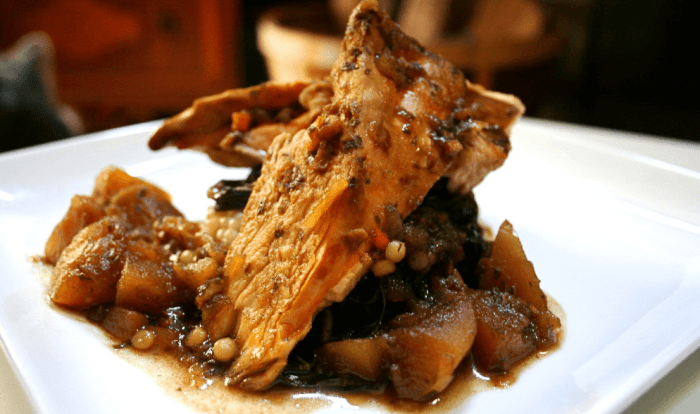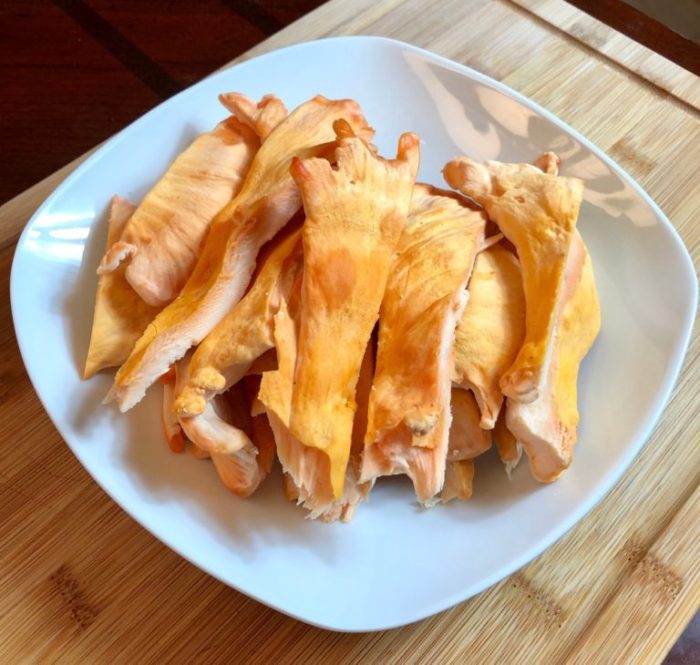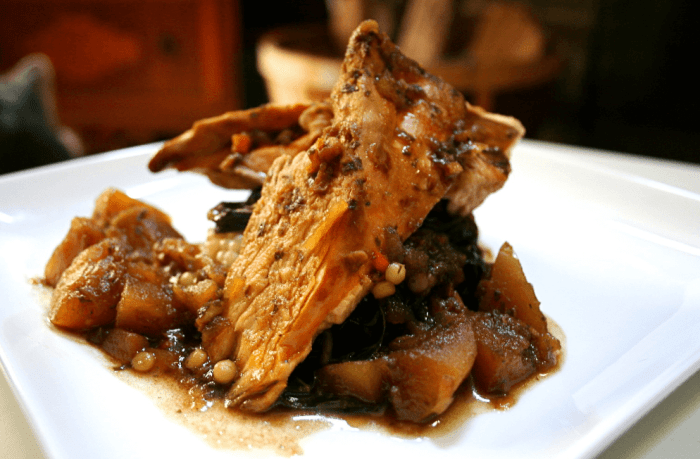
Prepare to embark on a culinary journey with our comprehensive guide to Chicken of the Woods Recipe, where we’ll uncover the secrets of this extraordinary mushroom. From its captivating appearance to its tantalizing flavor, we’ll explore the art of preparing and cooking this woodland delicacy.
Whether you’re a seasoned chef or a novice in the kitchen, our step-by-step instructions will guide you through the process of preparing Chicken of the Woods, ensuring you create a dish that will delight your taste buds and impress your dinner guests.
Introduction to Chicken of the Woods
Chicken of the Woods, scientifically known as Laetiporus sulphureus, is a highly prized edible mushroom that has been enjoyed by foragers and culinary enthusiasts for centuries. Its unique appearance and delectable flavor make it a sought-after delicacy in the culinary world.
Chicken of the Woods is characterized by its vibrant orange to yellow color, which resembles the plumage of a chicken. It grows in clusters on the trunks of dead or dying trees, particularly oak and maple. The mushroom has a meaty texture and a mild, slightly nutty flavor that is reminiscent of chicken, hence its name.
Culinary Significance
Chicken of the Woods is a versatile culinary ingredient that can be cooked in a variety of ways. It is often sautéed, grilled, or roasted and can be used in soups, stews, and stir-fries. Its meaty texture makes it a suitable substitute for chicken in many recipes, and its mild flavor allows it to pair well with a wide range of seasonings and sauces.
Preparation and Cooking Methods

Chicken of the Woods can be prepared and cooked in various ways to enhance its unique flavor and texture. Some popular methods include sautéing, grilling, and roasting. Each method brings out different characteristics of the mushroom, making it a versatile ingredient for culinary exploration.
Before cooking, it’s essential to clean the mushroom thoroughly. Gently brush away any dirt or debris using a soft brush or a damp cloth. Cut the mushroom into bite-sized pieces or strips for easier handling and even cooking.
Sautéing
Sautéing Chicken of the Woods is a quick and straightforward method that allows the mushroom to retain its juicy texture while developing a slightly crispy exterior. Heat a skillet or frying pan over medium heat. Add a drizzle of olive oil or butter and swirl to coat the pan.
Once the oil is shimmering, add the mushroom pieces and cook, stirring occasionally, until they are tender and slightly browned, about 5-7 minutes.
Grilling
Grilling Chicken of the Woods imparts a smoky flavor and a beautiful char. Preheat your grill to medium-high heat. Brush the mushroom pieces with olive oil and season with salt and pepper. Grill for 5-7 minutes per side, or until they are tender and have grill marks.
Roasting
Roasting Chicken of the Woods in the oven brings out its earthy notes and caramelizes its edges. Preheat your oven to 400°F (200°C). Toss the mushroom pieces with olive oil, salt, and pepper. Spread them on a baking sheet and roast for 15-20 minutes, or until they are tender and slightly crispy.
Preservation and Storage, Chicken of the woods recipe
Fresh Chicken of the Woods can be stored in the refrigerator for up to 3 days. Place the mushrooms in a paper bag or a container lined with a damp paper towel to maintain moisture. For longer storage, you can freeze the mushrooms for up to 6 months.
Blanch them in boiling water for 2 minutes, then drain and pat dry. Store the blanched mushrooms in freezer-safe bags or containers.
Recipe Variations and Pairings

Chicken of the Woods is a versatile mushroom that lends itself well to a variety of cooking methods and flavor profiles. From hearty soups and stews to savory stir-fries and grilled skewers, the possibilities are endless.
Side Dish Pairings
When selecting side dishes to accompany Chicken of the Woods, consider dishes that complement the earthy, umami flavor of the mushroom. Roasted vegetables, such as carrots, parsnips, and Brussels sprouts, provide a sweet and savory balance. Creamy polenta or mashed potatoes offer a comforting base to soak up the mushroom juices.
For a lighter option, a simple green salad with a tangy vinaigrette can help cut through the richness of the dish.
Beverage Pairings
To enhance the dining experience, consider pairing Chicken of the Woods with beverages that complement its robust flavor. Full-bodied red wines, such as Cabernet Sauvignon or Merlot, provide a rich and complex accompaniment to grilled or roasted mushrooms. For a lighter option, a crisp white wine, such as Sauvignon Blanc or Pinot Grigio, can balance the earthy notes of the mushroom.
If you prefer non-alcoholic beverages, a malty beer or a smoky tea can also make suitable pairings.
Recipe Table
The following table compares three popular Chicken of the Woods recipes, showcasing their ingredients, cooking times, and flavor profiles:
| Recipe | Ingredients | Cooking Time | Flavor Profile | Grilled Chicken of the Woods Skewers | Chicken of the Woods mushrooms, olive oil, salt, pepper | 15-20 minutes | Smoky, savory, umami | Creamy Chicken of the Woods Soup | Chicken of the Woods mushrooms, onion, garlic, vegetable broth, heavy cream | 30-45 minutes | Rich, creamy, earthy | Stir-Fried Chicken of the Woods with Vegetables | Chicken of the Woods mushrooms, broccoli, carrots, soy sauce, ginger | 10-15 minutes | Savory, tangy, slightly spicy |
|---|
Nutritional Value and Health Benefits
Chicken of the Woods is an excellent source of several essential nutrients. It is low in calories and fat, and a good source of protein, fiber, and vitamins. It also contains a number of minerals, including potassium, phosphorus, magnesium, and zinc.
Chicken of the Woods has been shown to have a number of potential health benefits. It has antioxidant, anti-inflammatory, and antibacterial properties. It has also been shown to boost the immune system and protect against cancer.
Key Nutrients and Benefits
- Protein:Chicken of the Woods is a good source of protein, which is essential for building and repairing tissues.
- Fiber:Chicken of the Woods is a good source of fiber, which can help to improve digestion and prevent constipation.
- Vitamins:Chicken of the Woods is a good source of vitamins, including vitamin C, vitamin D, and vitamin B12.
- Minerals:Chicken of the Woods is a good source of minerals, including potassium, phosphorus, magnesium, and zinc.
- Antioxidants:Chicken of the Woods contains a number of antioxidants, which can help to protect the cells from damage.
- Anti-inflammatory:Chicken of the Woods has anti-inflammatory properties, which can help to reduce inflammation in the body.
- Antibacterial:Chicken of the Woods has antibacterial properties, which can help to fight infection.
- Immune system:Chicken of the Woods can help to boost the immune system, which can help to protect against illness.
- Cancer:Chicken of the Woods has been shown to have anti-cancer properties, which may help to protect against cancer.
Sustainability and Conservation: Chicken Of The Woods Recipe
Chicken of the Woods is a resilient and abundant mushroom that can be harvested sustainably with proper practices. Its growth is not threatened by harvesting, as it can regenerate from its mycelium network. However, it’s essential to follow responsible foraging practices to ensure its long-term availability.
Responsible Foraging Practices
-
-*Harvest only mature specimens
Avoid picking young mushrooms, as they need time to produce spores and contribute to the population’s growth.
-*Cut, don’t pull
Use a sharp knife to cut the mushroom at the base, leaving the mycelium intact. Pulling can damage the mycelium and hinder future growth.
-*Respect the environment
Forage in designated areas, avoid disturbing the surrounding vegetation, and leave no trace of your presence.
-*Educate yourself
Learn to identify Chicken of the Woods accurately to avoid harvesting similar but potentially toxic species.
Conservation Efforts
Organizations and researchers are working to protect Chicken of the Woods and its habitats. These efforts include:
-
-*Habitat conservation
Protecting forests and other ecosystems where Chicken of the Woods thrives.
-*Research and monitoring
Studying the species’ biology, distribution, and sustainability to inform conservation strategies.
Chicken of the woods, a unique and flavorful mushroom, can be enjoyed in various dishes. One popular recipe involves sautéing the mushrooms in butter or olive oil, adding herbs and spices to enhance the flavor. For a more elaborate preparation, try the chicken of the woods recipe from McHenry County College.
This recipe incorporates the mushrooms into a creamy sauce, perfect for serving over pasta or polenta.
-*Public awareness
Educating the public about the importance of responsible foraging and the conservation of Chicken of the Woods.
Finding and Identifying Chicken of the Woods Sustainably
-
-*Look for mature specimens
They are typically large, with bright orange or yellow coloration.
-*Check the underside
Another delectable way to prepare chicken of the woods is by roasting them in the oven. Simply toss the mushrooms with olive oil, salt, and pepper, then roast at a high temperature until golden brown. This technique brings out the mushrooms’ natural sweetness and earthy flavor.
For a more detailed guide, check out the chicken of the woods recipe from Wake Technical Community College. Their recipe also includes a delicious glaze made with honey and soy sauce, adding a touch of umami to the roasted mushrooms.
The gills should be white or cream-colored and not bruised or discolored.
-*Consider the time of year
Chicken of the Woods typically fruits in late summer and fall.
-*Forage in healthy ecosystems
Look for areas with diverse vegetation, fallen logs, and moist conditions.
By following responsible foraging practices, supporting conservation efforts, and learning to identify Chicken of the Woods sustainably, we can ensure the availability of this delicious and nutritious mushroom for generations to come.
Closing Notes

As you delve into the world of Chicken of the Woods, you’ll not only discover its culinary versatility but also its nutritional value and potential health benefits. With its rich source of vitamins, minerals, and antioxidants, this mushroom offers a wholesome and delicious way to enhance your well-being.
So, gather your ingredients, ignite your culinary curiosity, and join us on this enchanting expedition into the realm of Chicken of the Woods Recipe. Let’s cook, savor, and celebrate the wonders of nature’s edible treasures!
Top FAQs
What is the best way to clean Chicken of the Woods?
Gently brush off any dirt or debris with a soft brush or a damp cloth. Avoid washing the mushrooms directly under running water, as they can absorb moisture and become soggy.
How long can I store Chicken of the Woods?
Fresh Chicken of the Woods can be stored in the refrigerator for up to 5 days. Cooked Chicken of the Woods can be stored in an airtight container in the refrigerator for up to 3 days.
Can I freeze Chicken of the Woods?
Yes, you can freeze Chicken of the Woods. Cut the mushrooms into desired pieces and spread them on a baking sheet lined with parchment paper. Freeze for several hours or overnight, then transfer to an airtight freezer-safe container. Frozen Chicken of the Woods can be stored for up to 6 months.





